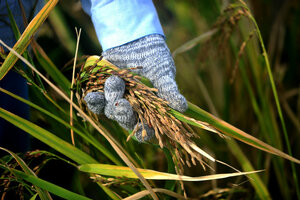Stockpiling seeds today saves plants for the future
A quarter of the world's plant species may be headed toward extinction. Seed banks aim to prevent that.

A Filipino farmer holds rice seeds and stalks at the International Rice Research Institute in Laguna, east of Manila. The fire-proof, quake-proof, typhoon-proof gene bank set up in 1962 now holds 115,000 varieties of one of the world's most important grains.
Noel Celis/AFP/Getty Images/Newscom/File
According to the Millennium Ecosystem Assessment, a quarter of the world’s known plant species – some 60,000 to 100,000 species – are threatened with extinction.
And even though plants may not receive as much attention as endangered animals, like polar bears or tigers, they’re extremely important. Plants are a vital source of food, they can help stabilize the climate, and they also provide shelter, medicines, and fuel.
The Kew Millennium Seed Bank (MSB), located at Wakehurst Place, in West Sussex, England, is working with its global network of partner organizations to bank seeds of rare and threatened plants. With 120 partner institutions in more than 50 countries, MSB is the largest plant conservation project in the world. In 2009, the bank achieved its target of collecting seeds from 10 percent of the world’s plant species. Its next goal is to secure 25 percent by 2020.
The bank was started with the simple idea of collecting and conserving the world’s wild plant species. Banking seeds of useful plants is the first step in finding varieties that can help confront pressing global problems – from water scarcity to deforestation to restoring endangered habitats.
“As seed conservationists, our role is not only to conserve plant diversity, but to make it available to as wide a range of users to enable both innovation and adaptation,” says Paul Smith, head of the seed bank at Kew.
The bank is making this information more accessible to a global network of researchers and scientists through its online databases. And scientists are working to understand how to turn these seeds into healthy plants. The bank sends out samples to institutes around the world to promote collaborative research across national borders.
Although there are more than 7,000 known edible plant species, 80 percent of our calorie intake comes from just 12 plant species – 8 grains and 4 tubers, Smith says. This means communities around the world are highly vulnerable to pests, diseases, and climate change.
Innovations that help identify food crops that use less water and are tolerant to drought can help boost food security, especially as climate change takes hold.
Many communities around the world – and especially in Africa – depend on plants for food, medicine, and fuel. In Kenya, MSB is working with farmers groups, government agencies, and community-led nurseries to collect, conserve, and use seeds from a variety of threatened species.
And in Burkina Faso, Dr. Sibou Sina of the National Forest Seed Center says that collaboration with MSB is helping to identify food crops that are resistant to erratic weather patterns, such as the devastating floods that hit West Africa last year.
MSB is showing that finding solutions to food security and climate change will require moving beyond the narrow range of plants that we rely on and taking advantage of a larger number of plant varieties. And preserving plant diversity offers tremendous potential for future innovation.
Janeen Madan is a communications associate with the Nourishing the Planet project.
To purchase State of the World 2011: Innovations that Nourish the Planet please click HERE. And to watch the one minute book trailer, click HERE.
• This article originally appeared on the blog Nourishing the Planet, published by the Worldwatch Institute.
